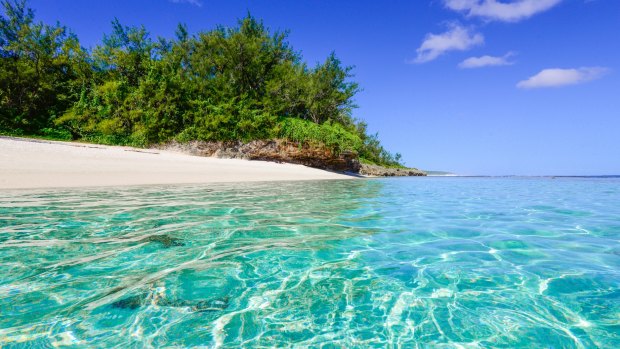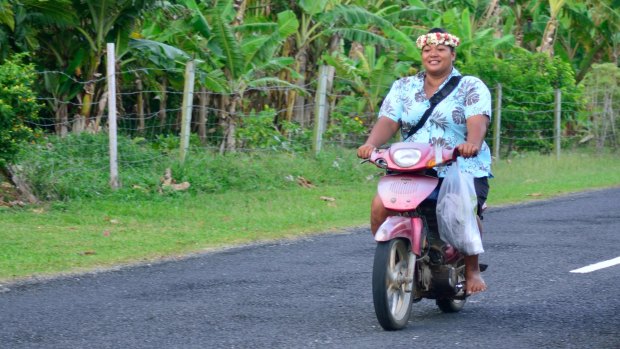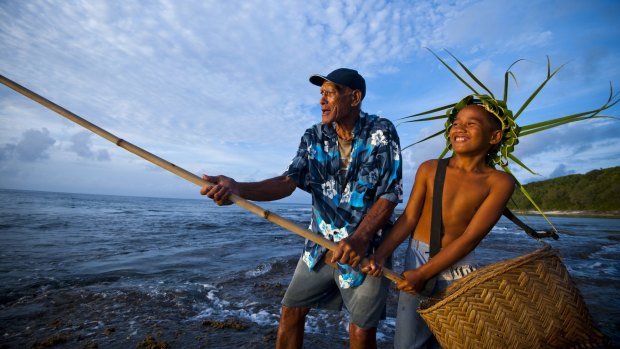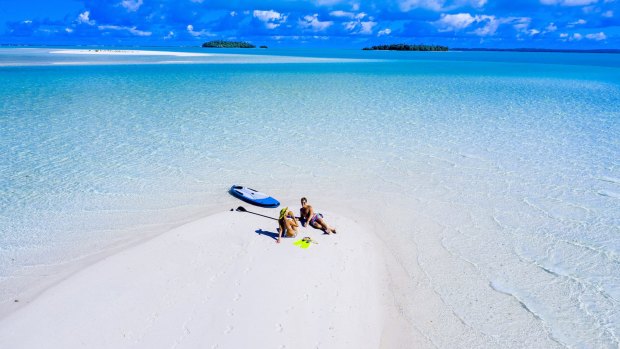This was published 5 years ago
Atiu and Aitutaki, Cook Islands: Beyond Rarotonga are islands where you can truly escape
By Craig Tansley

While Atiu lacks the lagoons of Rarotonga or Aitutaki, there are aqua treats on hand.
The modern world might've come to Atiu; but most days the bush telegraph still works better than the Wi-Fi. When the signal's on the blink in town – or what constitutes town on a speck of fossilised coral this deep in the South Pacific – I ride my scooter along "the highway" (locals call it so, because it's the only real strip of bitumen on the island). I turn off and drive up a dirt track to the communications antenna, beside the paw-paw patch. Then I poke my iPhone high into the sky, angling it in every conceivable position to catch signals that usually aren't there. The Wi-Fi's not much chop, but I bet the bush telegraph's working fine: the whole island must know about the idiot tourist standing on his tippy-toes, desperate for his daily dose of Facebook.
Other than Wi-Fi, there's not much on Atiu that reminds me of 2019. When I drive all the way round its dirt coast road – dodging coconuts and coconut crab holes, and never once managing to shift out of second gear – I don't pass another vehicle. The only rush hour worth avoiding on Atiu is the queue for fresh-cooked donuts each morning at 6.30 outside the island's only bakery. The owner of the villas I'm staying at (they're the only villas on Atiu) tells me if I see another scooter parked by a beach, to move on to the next (there's 26 of them): "No one likes a crowd on Atiu," he says. But I never do.
This kind of holiday isolation is generally only found by the hardiest backpackers in far-flung destinations; places requiring days of intricate travel scheduling to get to. But not Atiu; it's 45 minutes flying time from Rarotonga, the capital of the Cook Islands. And though Atiu's the third most visited island of the Cooks, you'll still be one of only 500 tourists each year who visits.

If you see a scooter parked at the beach, move on to the next one. No one likes a crowd.Credit: iStock
Rarotonga's hardly a metropolis, mind you – this is an island which sticks to the rule that no building be taller than the tallest coconut tree – but compared to Atiu, it might as well be Waikiki. Most visitors won't make it beyond Rarotonga (and still barely 25,000 Australians make it this far in a typical year). But for those willing to tread further, privacy is assured… Robinson Crusoe you can be. The last vestiges of Earth are being colonised by Starbucks, Holiday Inn and Burger King, but there's 14 islands of the Cooks beyond Rarotonga, spread across an area of ocean equal in size to western Europe (two million square kilometres), home to less than 14,000 Polynesians.
Getting to some of them requires deep pockets, but not Atiu. I arrive on a direct flight in a propeller plane beside supplies for Nana Roberts in an over-sized Bluebird Chicken Chips box that rattles when we touch down on the island's compacted coral runway. Though Atiu's barely 200 kilometres from Rarotonga, there's less than 450 locals living here. When I first came, in 2005, there was one restaurant on the island. And now? There's one restaurant on the island. But foodies might consider deep-sea fishing or casting a line in the lagoon, or joining locals cray-fishing at night by torchlight, then cooking up what you catch over the coals of a beach barbecue.
Though it's adventurists who should come; to an island littered with limestone caves, full of human skulls. There are burial caves all over the island, and there's the Anatakitaki Caves, home to one of the world's rarest creatures – a swift-like bird (kopeka) which navigates its way in the dark by using a series of clicks. Local guide Ben Isaia takes me deep under the earth here, lighting candles so I can enjoy a moody dip in an artesian water pool.

Foodies on Atiu might consider deep-sea fishing or casting a line in the lagoon, or joining locals cray-fishing at night by torchlight.Credit: Kirklandphotos
Atiu is also known as Enuamanu, or Island of the Birds. Birdman George (Mateariki) guides me through some of the best-preserved forests left in Polynesia to spot one of the planet's most endangered bird species, the kakeroi (Rarotongan flycatcher). We tip-toe through foliage beside rugged coastline of sharp makatea (fossilised coral) where waves thunder on to the shore, shaking the earth, near a bay where Captain Cook once landed.
There's plenty to do here, odd really for an island of subsistence farmers – beyond the caves and birds there's everything from coffee plantation tours to bush beer bar crawls (called tumunus, this is where locals retreated to when missionaries brought their strict laws into practice in the mid-1800s) – though I think the appeal to an island like Atiu is in doing nothing at all. I spend one day of three moving about with no purpose at all, driving slowly down dirt roads as piglets and baby goats bolt in front of me.
Air Rarotonga's two-island/four-night combo allows me two nights on Atiu before I'm flown to Aitutaki, 40 minutes north-west (guests can choose which island they prefer to visit first in line with flight schedules). Aitutaki's lagoon is the stuff of South Seas legends – shaped like an equilateral triangle, it (at 74 square kilometres) dwarfs Aitutaki itself (17 square kilometres). This is the lagoon that spawned the hit series Survivor; its allure is only topped in Polynesia by Hollywood's favourite honeymoon, Bora Bora.

Visit one of the Pacific's most revered lagoons at Aitutaki.
Fourteen tiny islands (motu) sit in shocking blue, all but one of which are uninhabited. Even on rainy days the water's so clear around here, you barely need a mask and snorkel. And yet it's just a small part of the appeal of Aitutaki. For nowhere combines complete isolation with holiday chic anywhere in the South Pacific quite like Aitutaki does. And so being here is like being in Atiu, but in a more recent decade.
There's definitely elements of backwater about this island – there's no driving tests here like there are on Rarotonga; make it to the cop shop on your motorbike in one piece and you've got your licence, and guests constantly ask hotel staff where town is, not realising they've driven through it many times already – but it's also home to some of the Pacific's most awarded five-star resorts. At mine; the GM claps chickens out of the restaurant before I eat, and goats keep the grass mown, and two resorts make up the property, separated by the owners' auntie's house in the middle. In the mornings before breakfast, luxury comes not in any elaborately conceived breakfast menu, but from sunrise paddles on a SUP across a lagoon teeming with tiny silver fish.
Everyone waves to me on Aitutaki, and no one locks doors. If I dared use the hotel safe, I reckon the cleaners would be disappointed in me. Entire families ride around the island on the one moped, and on Sundays Aitutaki shuts down for church; a jovial affair it is too: singing and eating's far more meaningful than any sermon. I watch an entire island's population preen themselves with coconut oil, then transport themselves by bus, bike, car and foot to the oldest church in the Cook Islands, in the village of Arutanga.
And then I'm back in Rarotonga, and now this sleepy Pacific outpost feels like a megalopolis. The Wi-Fi works, cars whiz by me at 40km/h, tourists sit at tables beside me in cafes sharing my holiday and a couple in a rent-a-convertible swim at the same beach I'm sitting on (move along if you see my bike, people). There's so few opportunities left in this world to truly escape; seizing the opportunity to do so comes with its share of re-entry quandaries.
TRIP NOTES
FLY
Air New Zealand flies direct to Rarotonga from Sydney every Friday night, or via New Zealand from Australia's east coast daily from $800 return, see airnewzealand.com.au
TOUR
Air Rarotonga's Aitutaki/Atiu two-island, four-night combo includes round-trip airfares from Rarotonga, Aitutaki and Atiu, airport transfers, and two nights' accommodation each at Tamanu Beach Hotel and Atiu Villas for $NZ1147.50 per adult, based on twin share, or $NZ1788 for a single traveller (extra nights can be added), see airraro.com/en/tours/aitutaki-atiu-island-combo
MORE
Craig Tansley was a guest of Cook Islands Tourism, AirNZ and Air Rarotonga
OTHER COOK ISLANDS TO VISIT
Most of the Cook Islands' Southern Group are relatively easy to access, with regular flights from Rarotonga, including Mitiaro, Mangaia and Mauke. Others within the Northern Group are much harder to visit, but well worth the effort (with Air Rarotonga's Northern Atolls Experience), including Pukapuka and Manihiki. See cookislands.travel
MITIARO
Located 263 kilometres from Rarotonga, there's fewer than 200 people living on Mitiaro. Stay with local families, and observe life across four villages, exploring the island's freshwater lakes, subterranean caves and pools and beaches.
MANGAIA
Located 200 kilometres from Rarotonga, Mangaia is steeped in legends, and is the oldest island in the Pacific. There's villas on the island, or stay with families. You'll find some of the rarest birds in the Pacific, and you can also traverse caves kilometres in length.
MAUKE
Located 280 kilometres from Rarotonga, Mauke is known as the Garden Island for its abundance of flowers. Stay with local families, exploring the island's lakes and caves, observing island life in a community with fewer than 200 visitors a year.
PUKAPUKA
Located 1300 kilometres north-west of Rarotonga, Pukapuka is actually closer to Samoa. Its lagoon is as stunning as Aitutaki's world-renowned lagoon, but few have seen it. Stay in a guest house or with a local family.
MANIHIKI
Located 1250 kilometres north-east of Rarotonga, Manihiki is made up of 43 tiny islets surrounded by a deep, nine-kilometre-wide lagoon that's home to the Cook Islands' black pearl industry. Less than 400 people live in villages on two islets.
Sign up for the Traveller Deals newsletter
Get exclusive travel deals delivered straight to your inbox. Sign up now.